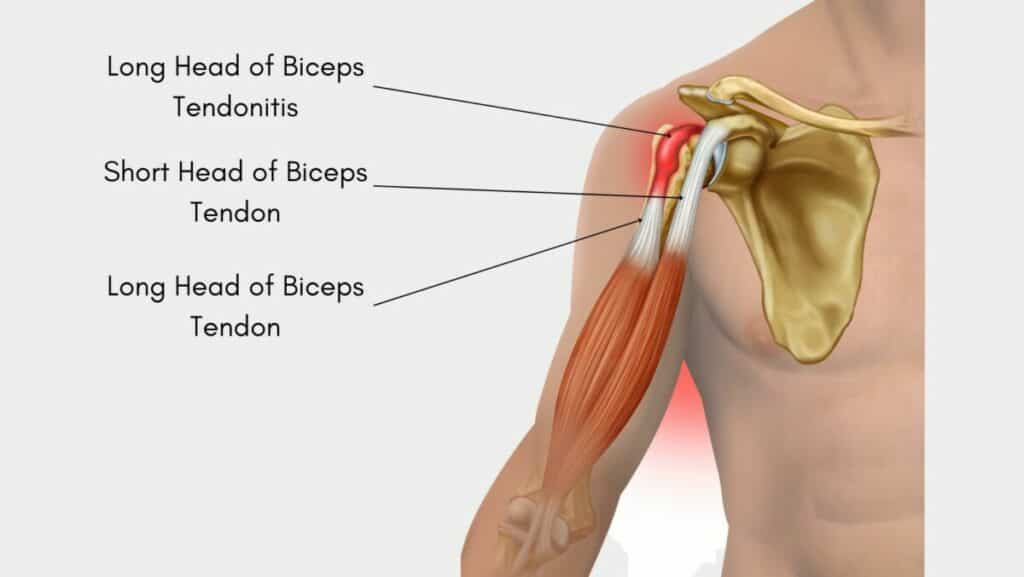Long Head of Biceps Tendonitis
- Does Swimming Build Muscle - October 22, 2023
- How To Sleep With A Frozen Shoulder - June 28, 2023
- Bankart Lesion - March 30, 2023
What is Biceps Tendonitis?
A biceps tendonitis or biceps tendinopathy is a painful condition involving one of the two origins of the biceps tendon around the shoulder. The biceps muscle sits anteriorly in the arm and has two main functions around the elbow: supination (i.e. bringing the palm of your hand up) and elbow flexion. On top of that, the biceps are divided into two main portions: the short and long head of the biceps (LHB).
The LHB has the vital function of stabilising the humeral head into the glenoid cavity (i.e. the socket), and it lays in a “tunnel” named the bicipital groove. It is essential to mention that the LHB also has a meaningful connection with the glenoid labrum, another important structure that grants stability to the shoulder complex.
Biceps Tendonitis Causes
An overload of the LHB tendon due to a sudden burst of activity is generally responsible for the symptoms. A typical example is someone that starts back at the gym with intense upper body work after having the summer off. Similarly, moving houses over the weekend could also sensitise the LHB tendon due to increased heavy lifting and moving objects overhead.
Lastly, repetitive use of the arms overhead, as in a baseball pitcher or a window cleaner, could also lead to LHB tendinopathy.

Biceps Tendonitis Symptoms
Symptoms generally include pain at the front of the shoulder and arm weakness. Initially, symptoms may be present only before and after physical activity. There may also be some associated stiffness in the morning. In more irritable cases, generally, when patients come and see us, pain may be constant and more widespread around the shoulder, while it may also wake you up at night.
In long-standing presentations, the LHB tendon may be degenerated, with potential instability of the tendon itself. This may lead to a snapping LHB tendon. Due to its close relationship with the glenoid labrum, a snapping LHB tendon may also cause repetitive injury to the labrum, causing shoulder instability over time.
Treatment for Biceps Pain
LHB tendinopathy
Management of LHB tendinopathy is usually conservative and involves appropriate education on the reason that led to the development of pain, which is a sudden burst of tendon loading. Hence, reducing the amount of activity that overloaded the tendon in the first place is essential. In case of an acute LHB tendinopathy with irritable symptoms, you should ask your GP to prescribe some basic anti-inflammatories medication.
The rehabilitation phase will involve progressive tendon loading in your rehab exercises and hobbies/work. Isometric contraction should be preferred at first, followed by eccentric and concentric exercises. The loading on the biceps tendon could be increased by manipulating the lever of an exercise (short lever first, long lever after), the weight and resistance utilised, as well as the speed of execution.
Should a thorough loading program fail to address your symptoms, an ultrasound-guided corticosteroid injection may be proposed to decrease pain. Other clinicians may also use PRP or hyaluronic acid injections. Nonetheless, you should be aware that this may negatively affect tendon health in the long run, potentially leading to LHB tendon rupture.
Snapping biceps tendon or dislocated biceps tendon
In these cases, an Orthopaedic consultation should be performed. Surgery generally involves a tenotomy, in which the tendon is cut to be released, or a tenodesis, in which the tendon is moved and reattached to the bone with a small anchor.
Exercises for Long Head of Biceps
1: Isometric Curl with Band
- Take a resistance band and place it under both feet whilst sitting
- Sit upright and rest your hands on your knees to add a little tension to the band
- Using your right arm with your thumb uppermost bend at your elbow to the midrange
- Hold for 15 seconds and slowly lower your hands down
- Repeat 6 times, 3 sets
2: Bent Over Row on Bench with Dumbbell
- Place one knee and hand from the same side on a bench
- Hold a dumbbell (5-8kg) in the other hand with a straight arm and good posture
- Pull the dumbbell up to the shoulder
- Lower the dumbbell down
- Repeat 12 times, 3 sets
3: Front Raise & Rotation with Dumbbell
- Hold a dumbbell in one hand (1/1.5kg)
- Keep your arm straight and raise it to shoulder height
- Rotate your arms outwards
- Lower your arm down to the side
- Repeat 12 times, 3 sets
4: Shoulder Flexion in Prone with Dumbbell
- Lie face down on a bed holding a dumbell (1/2kg) over the edge
- Raise the arm forward above the head whilst rotating your palms towards the ceiling
- Hold for 2 seconds, then lower the hand down
- Repeat 12 times, 3 sets
__________________________________
We are specialists in treating shoulder conditions such as Biceps Tendonitis and have experts in shoulder conditions in our clinic in Fulham, South West London.
Related Articles
Subscapularis Tendonitis – Osteopathy vs Physiotherapy – How often should you have a sports massage?
